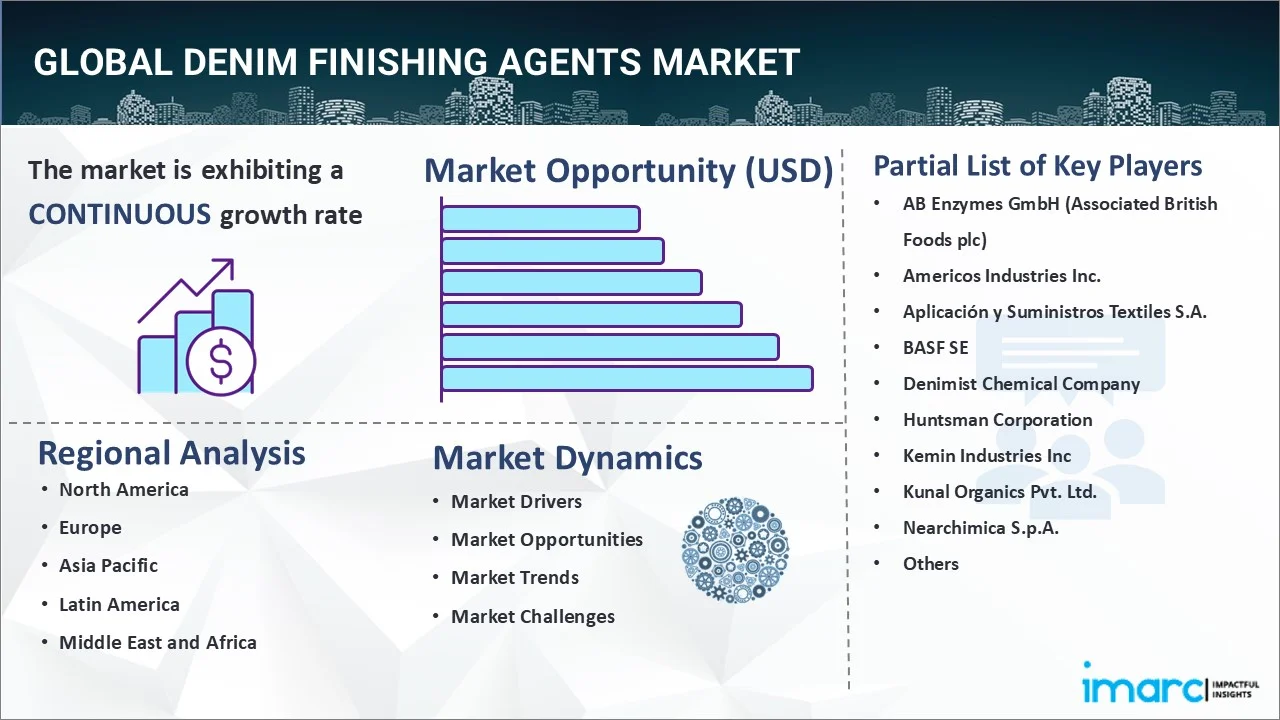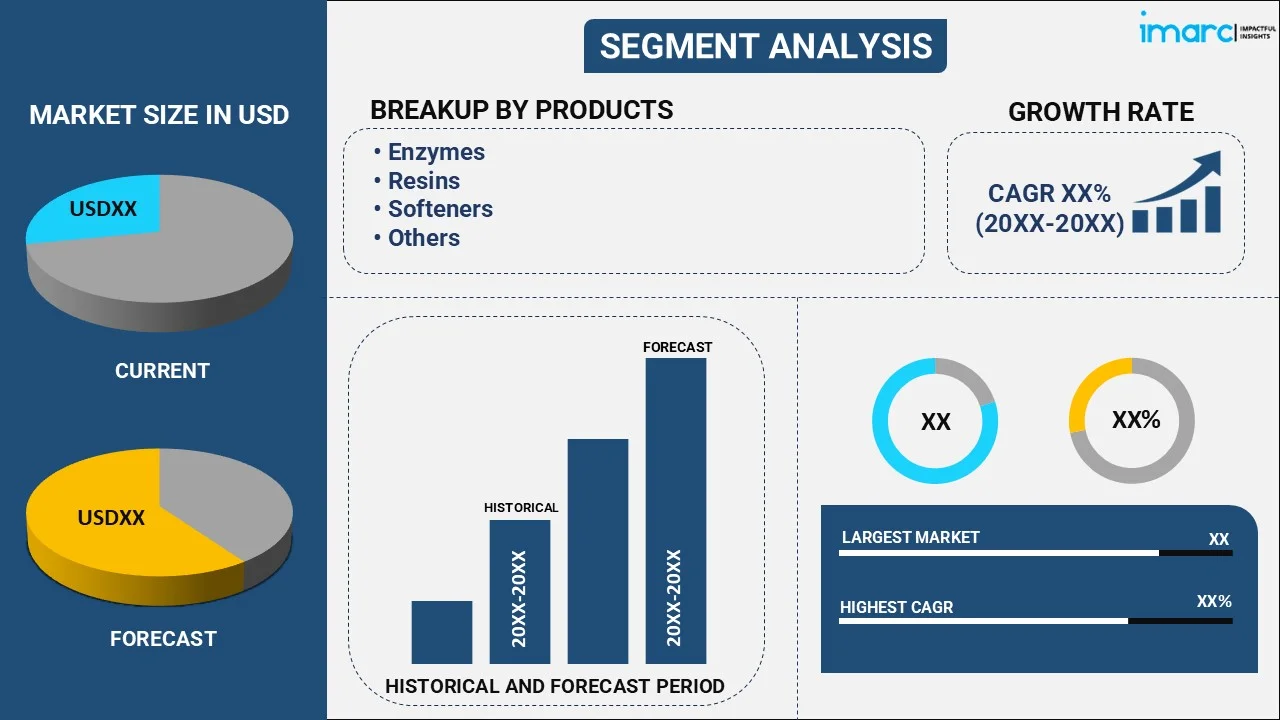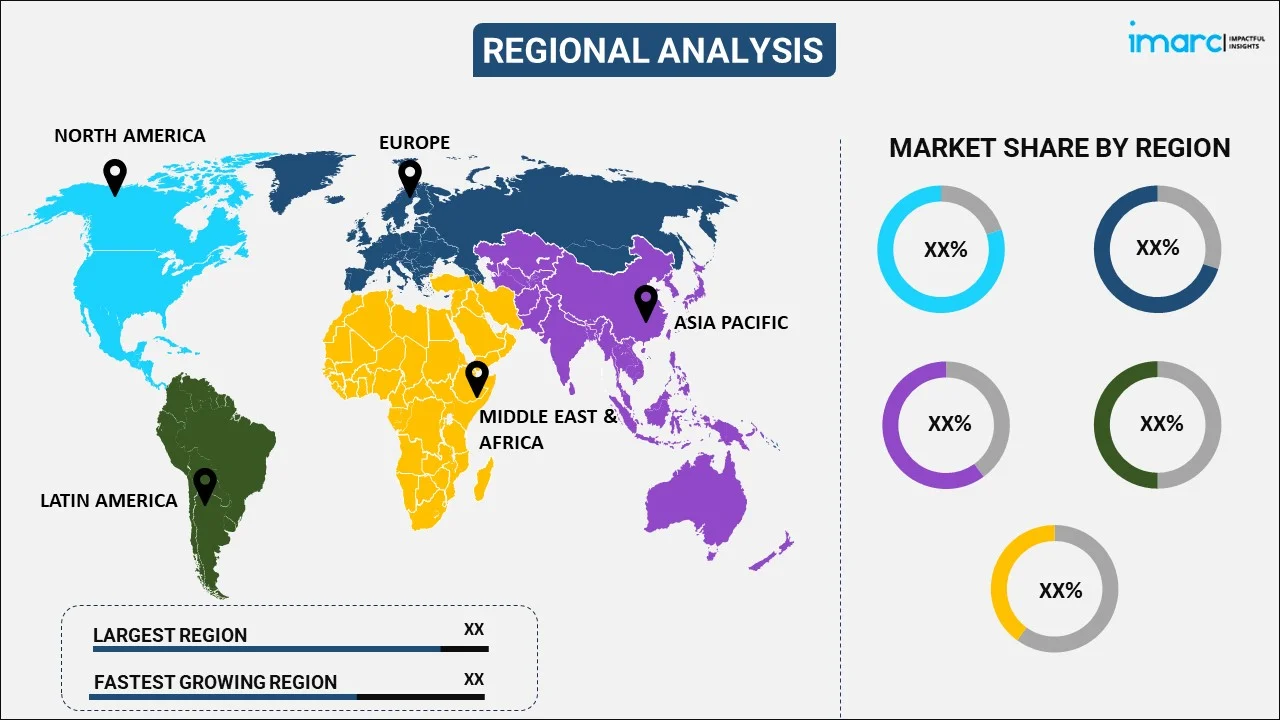
Denim Finishing Agents Market Report by Product (Enzymes, Resins, Softeners, Defoamers, Anti-Rusting Agent, Crush Resistant, Anti-Back Staining Agent, and Others), Enterprises Size (Small and Medium Enterprises, Large Enterprises), Distribution Channel (Manufacturer/Distributor/Service Provider, Aftermarket), and Region 2025-2033
Denim Finishing Agents Market Size:
The global denim finishing agents market size reached USD 1.7 Billion in 2024. Looking forward, IMARC Group expects the market to reach USD 2.7 Billion by 2033, exhibiting a growth rate (CAGR) of 4.9% during 2025-2033. The market is propelled by environmental sustainability and regulations, technological advancements, and the growing demand for high-quality denim apparel, driving innovations in eco-friendly and advanced finishing processes to meet consumer preferences and regulatory standards.
|
Report Attribute
|
Key Statistics
|
|---|---|
|
Base Year
|
2024
|
|
Forecast Years
|
2025-2033
|
|
Historical Years
|
2019-2024
|
|
Market Size in 2024
|
USD 1.7 Billion |
|
Market Forecast in 2033
|
USD 2.7 Billion |
| Market Growth Rate (2025-2033) | 4.9% |
Denim Finishing Agents Market Analysis:
- Major Market Drivers: The growing fashion sector and customers' need for high-end, long-lasting denim fabrics are the main drivers of the denim finishing agents market. New developments in denim finishing technologies, enable a variety of surface looks and textures, which are another factor driving industry expansion.
- Key Market Trends: The denim finishing agents market recent developments include the growing inclination toward skin-friendly and environmentally sustainable goods which is escalating the usage of organic and natural finishing chemicals. For example, natural softeners and plant-based enzymes.
- Geographical Trends: The Asia-Pacific market, particularly countries including China, India, and Bangladesh, are expanding due to their growing textile manufacturing industries and export capabilities. The region benefits from low labor costs, substantial production capacities, and strong governmental support.North America and Europe are experiencing growth in demand for sustainable and high-quality finishing agents, driven by environmental regulations and consumer awareness. These regions show a strong preference for innovative and eco-friendly denim finishes.
- Competitive Landscape: AB Enzymes GmbH (Associated British Foods plc), Americos Industries Inc., Aplicación y Suministros Textiles S.A., BASF SE, Denimist Chemical Company, Huntsman Corporation, Kemin Industries Inc, Kunal Organics Pvt. Ltd., Nearchimica S.p.A., Organic Dyes and Pigments LLC, Rudolf GmbH, and The Seydel Companies Inc., are among some of the key players in the denim finishing agents industry.
- Challenges and Opportunities: The emerging challenge in the market is adhering to stringent environmental regulations worldwide, requiring continuous research and development (R&D) efforts to produce compliant and sustainable products. It also holds opportunities for developing bio-based and recycled finishing agents that can meet environmental standards and consumer expectations for performance and feel. It is essential to understand the denim finishing agents market overview to guide these challenges and opportunities for market growth and development.

Denim Finishing Agents Market Trends:
Environmental Sustainability and Regulations
The increasing weight of the environmental sustainability movement led to stricter regulations regarding the use of chemicals and water in the market. The industry is widely employing indigo dyes that are infamously challenging to mortify, resulting in numerous cynical effects on the ecological system. These regulations compel manufacturers to adopt eco-friendly denim finishing agents, which use less water and are less toxic. Nowadays, Azole dyes account for about half of the 600,000 tons of dyes produced worldwide which are employed in the textile industry, including the denim sector. For instance, the denim industry affects the attainment of the UN sustainable development goals by 2030, SDG6 is affected by the excessive release of enough contaminated water with toxic substances, dyes, and other adhesives and the manufacture of denim contributes to the higher production of greenhouse gas (GHG), making it an essential industry for climate change and growth described under SDG13.
Technological Advancements
The denim industry is witnessing significant technological advancements in finishing processes, which aim to enhance the functionality, comfort, and aesthetic appeal of denim. Advanced technologies such as laser finishing, ozone treatment, and nano-bubble technology offer efficient and sustainable alternatives to conventional finishing methods. For instance, a Spanish company Jeanologia, developed and patented a technology based on nanobubbles known as e-flow. The garment's surface is broken up by the e-flow, which produces a soft hand feel and reduces shrinking, which works with a small amount of water, and the procedure produces no waste. Along with this, the generation of nanobubbles and the use of these as a vehicle for transferring to the textile material properties of either water, a chemical agent, or a gas is intended for changing the characteristics of the textile material.
Growing Demand for High-Quality Denim Apparel
The demand for high-quality denim apparel is driving the denim finishing agents' market growth. Consumers are seeking denim products that offer comfort, durability, and unique aesthetics, such as vintage looks or soft finishes. The market is also witnessing a rise in premium denim brands that focus on high-quality finishes and distinctive styles, further fueling the demand for advanced denim finishing agents. For example, an anti-back-staining agent excels at absorbing and dispersing insoluble indigo, effectively dispersing the dyes produced by enzyme washing in the washing solution. This achieves the anti-staining effect, refined biodegradability, making it environmentally friendly and generating significant denim finishing agent market revenue.
Denim Finishing Agents Industry Segmentation:
IMARC Group provides an analysis of the key trends in each segment of the market, along with forecasts at the global, regional, and country levels for 2025-2033. Our report has categorized the market based on product, enterprise size, and distribution channel.
Breakup by Product:

- Enzymes
- Resins
- Softeners
- Defoamers
- Anti-Rusting Agent
- Crush Resistant
- Anti-Back Staining Agent
- Others
Softeners account for the majority of the market share
The report has provided a detailed breakup and analysis of the market based on the product. This includes enzymes, resins, softeners, defoamers, anti-rusting agents, crush-resistant, anti-back staining agents, and others. According to the report, softeners represented the largest segment.
Softeners hold a massive market share due to their decisive role in enhancing the comfort and hand feel of denim fabrics. They are applied to denim to impart a softer touch, refine fabric stretch, and secure comfort in wear which is driven by consumer preference for comfortable and soft-to-touch denim apparel. It is further supported by the appeal of numerous denim clothing styles, including premium jeans, distressed, vintage, and faded-looking denim clothing. Consequently, the expanding premium denim jeans market which is expected to reach US$ 14.1 Billion by 2032, exhibiting a growth rate (CAGR) of 4.5% during 2024-2032 as stated by IMARC Group is escalating the use of softeners. Currently, manufacturers are offering eco-friendly and sustainable softeners that meet environmental standards without compromising on performance accelerating the denim finishing agents market revenue.
Breakup by Enterprise Size:
- Small and Medium Enterprises
- Large Enterprises
Small and medium enterprises hold the largest share of the industry
A detailed breakup and analysis of the market based on the enterprise size have also been provided in the report. This includes small and medium enterprises and large enterprises. According to the report, small and medium enterprises accounted for the largest market share.
Small and medium enterprises (SMEs) represent the largest market attributed to the growing number of SMEs in the global textile and apparel industry, particularly in developing countries where they play a significant role in economic development and employment. It specializes in niche markets or bespoke denim finishes, requiring specific types of finishing agents that can be applied in smaller, more flexible production runs, thus creating denim finishing agents market opportunities. These enterprises are typically more agile and can quickly adapt to changing market trends, such as the increasing demand for eco-friendly and sustainable practices, changing denim finishing agents market outlook. For example, Archroma, a prominent leader in the market introduced Archoma’s DENISOL PURE INDIGO 30, to minimize indigo solution, which makes it possible to manufacture indigo-dyed denim without aniline impurities throughout the process.
Breakup by Distribution Channel:
- Manufacturer/Distributor/Service Provider
- Aftermarket
The report has provided a detailed breakup and analysis of the market based on the distribution channel. This includes manufacturer/distributor/service provider, aftermarket.
Manufacturer/distributor/service provider consists of the initial point in the supply chain where denim finishing agents are produced and provided directly to textile manufacturers or through a network of distributors and service providers. It is the primary channel for denim manufacturers to obtain numerous finishing agents that adapt to their specific needs, comprehending sustainable, water-saving, and innovative chemical formulations invented to refine the worth and use of denim fabrics.
Besides this, the aftermarket provision to the demand of textile manufacturers seeks to upgrade or modernize their existing denim finishing processes with new or specialized agents. It allows for the revitalization of denim products through the application of advanced finishing agents. For instance, in January 2022, AG Adriano Goldschmied, Inc., a prominent denim and knitwear house, collaborated with Tulip, a global leader in cloud-based mobile solutions to provide retail technology solutions that break down barriers and create authentic customer connections, as well as personalized shopping experiences for AG customers which is expanding their distribution network. Denim finishing agents market statistics indicate the essential of these entities for shaping the industry and meeting evolving market demands.
Breakup by Region:

- North America
- United States
- Canada
- Asia-Pacific
- China
- Japan
- India
- South Korea
- Australia
- Indonesia
- Others
- Europe
- Germany
- France
- United Kingdom
- Italy
- Spain
- Russia
- Others
- Latin America
- Brazil
- Mexico
- Others
- Middle East and Africa
Asia Pacific leads the market, accounting for the largest denim finishing agents market share
The market research report has also provided a comprehensive analysis of all the major regional markets, which include North America (the United States and Canada); Asia Pacific (China, Japan, India, South Korea, Australia, Indonesia, and others); Europe (Germany, France, the United Kingdom, Italy, Spain, Russia, and others); Latin America (Brazil, Mexico, and others); and the Middle East and Africa. According to the report, Asia Pacific accounted for the largest market share.
The Asia Pacific dominates the denim finishing agents market growth due to the expanding textile manufacturing industry. Countries such as China, India, and Bangladesh are major hubs for denim production, attributed to their vast textile manufacturing capabilities and the availability of labor. As a result, the denim finishing agents' market outlook involves key players investing in the industry to stay ahead of the competition. At the Bharat Tex April 2024, Madhusudan Group, India’s largest textile exhibition announced a visionary textile ecosystem, which is set to be the first bi-component spinning facility in the country that aligns with the global shift toward diversifying supply chains.
Competitive Landscape:
- The market research report has also provided a comprehensive analysis of the competitive landscape in the market. Detailed profiles of all major companies have also been provided. Some of the major market players in the denim finishing agents industry include AB Enzymes GmbH (Associated British Foods plc), Americos Industries Inc., Aplicación y Suministros Textiles S.A., BASF SE, Denimist Chemical Company, Huntsman Corporation, Kemin Industries Inc, Kunal Organics Pvt. Ltd., Nearchimica S.p.A., Organic Dyes and Pigments LLC, Rudolf GmbH, and The Seydel Companies Inc.
(Please note that this is only a partial list of the key players, and the complete list is provided in the report.)
- At present, leading companies are heavily investing in research and development (R&D) to innovate and develop new denim finishing agents that comply with international environmental standards. The Implementation of advanced technologies such as nano-technology, enzyme-based solutions, and digital applications offer sustainable high-quality finishes. They are working on improving the transparency of their supply chains and obtaining certifications from recognized environmental organizations to build trust with consumers while complying with regulatory requirements. For instance, in March 2022, Hennes & Mauritz AB (H&M) introduced the denim collection presenting a new water-saving process alternation that concentrates on reserving water in all stages and collaborating with producers that have water recycling initiatives.
Latest News:
- January 2024: Hyosung offered their 2024 denim-focused sustainable textiles and sourcing at Kingpins NYC.
- February 2023: Archroma, a global leader in specialty chemicals finalized the acquisition of Huntsman Textile Effects.
Denim Finishing Agents Market Report Scope:
| Report Features | Details |
|---|---|
| Base Year of the Analysis | 2024 |
| Historical Period | 2019-2024 |
| Forecast Period | 2025-2033 |
| Units | Billion USD |
| Scope of the Report | ey Insights for Sulfur Trioxide Manufacturing Plant SetuExploration of Historical Trends and Market Outlook, Industry Catalysts and Challenges, Segment-Wise Historical and Future Market Assessment:
|
| Products Covered | Enzymes, Resins, Softeners, Defoamers, Anti-Rusting Agent, Crush Resistant, Anti-Back Staining Agent, Others |
| Enterprise Sizes Covered | Small and Medium Enterprises, Large Enterprises |
| Distribution Channels Covered | Manufacturer/Distributor/Service Provider, Aftermarket |
| Regions Covered | Asia Pacific, Europe, North America, Latin America, Middle East and Africa |
| Countries Covered | United States, Canada, Germany, France, United Kingdom, Italy, Spain, Russia, China, Japan, India, South Korea, Australia, Indonesia, Brazil, Mexico |
| Companies Covered | AB Enzymes GmbH (Associated British Foods plc), Americos Industries Inc., Aplicación y Suministros Textiles S.A., BASF SE, Denimist Chemical Company, Huntsman Corporation, Kemin Industries Inc, Kunal Organics Pvt. Ltd., Nearchimica S.p.A., Organic Dyes and Pigments LLC, Rudolf GmbH, The Seydel Companies Inc., etc. |
| Customization Scope | 10% Free Customization |
| Post-Sale Analyst Support | 10-12 Weeks |
| Delivery Format | PDF and Excel through Email (We can also provide the editable version of the report in PPT/Word format on special request) |
Key Benefits for Stakeholders:
- IMARC’s industry report offers a comprehensive quantitative analysis of various market segments, historical and current market trends, market forecasts, and dynamics of the denim finishing agents market from 2019-2033.
- The research report provides the latest information on the market drivers, challenges, and opportunities in the global denim finishing agents market.
- The study maps the leading, as well as the fastest-growing, regional markets. It further enables stakeholders to identify the key country-level markets within each region.
- Porter's five forces analysis assists stakeholders in assessing the impact of new entrants, competitive rivalry, supplier power, buyer power, and the threat of substitution. It helps stakeholders to analyze the level of competition within the denim finishing agents industry and its attractiveness.
- The competitive landscape allows stakeholders to understand their competitive environment and provides insight into the current positions of key players in the market.
Key Questions Answered in This Report
The denim finishing agents market was valued at USD 1.7 Billion in 2024.
We expect the global denim finishing agents market to exhibit a CAGR of 4.9% during 2025-2033.
The rising demand for denim finishing agents to eliminate the impurities, enhance the stiffness to ensure dimensional stability, and improve the appearance, luster, and water and flame-resistance of the fabric, is primarily driving the global denim finishing agents market.
The sudden outbreak of the COVID-19 pandemic had led to the implementation of stringent lockdown regulations across several nations, resulting in the temporary halt in numerous production activities for denim finishing agents.
Based on the product, the global denim finishing agents market has been segmented into enzymes, resins, softeners, defoamers, anti-rusting agent, crush resistant, anti-back staining agent, and others. Among these, softeners currently hold the majority of the total market share.
Based on the enterprise size, the global denim finishing agents market can be divided into small and medium enterprises and large enterprises. Currently, small and medium enterprises exhibit a clear dominance in the market.
On a regional level, the market has been classified into North America, Asia-Pacific, Europe, Latin America, and Middle East and Africa, where Asia-Pacific currently dominates the global market.
Some of the major players in the global denim finishing agents market include AB Enzymes GmbH (Associated British Foods plc), Americos Industries Inc., Aplicación y Suministros Textiles S.A., BASF SE, Denimist Chemical Company, Huntsman Corporation, Kemin Industries Inc, Kunal Organics Pvt. Ltd., Nearchimica S.p.A., Organic Dyes and Pigments LLC, Rudolf GmbH, and The Seydel Companies Inc.
Need more help?
- Speak to our experienced analysts for insights on the current market scenarios.
- Include additional segments and countries to customize the report as per your requirement.
- Gain an unparalleled competitive advantage in your domain by understanding how to utilize the report and positively impacting your operations and revenue.
- For further assistance, please connect with our analysts.
 Inquire Before Buying
Inquire Before Buying
 Speak to an Analyst
Speak to an Analyst
 Request Brochure
Request Brochure
 Request Customization
Request Customization




.webp)




.webp)












